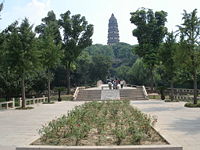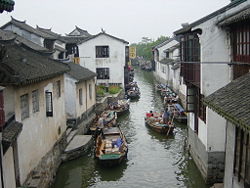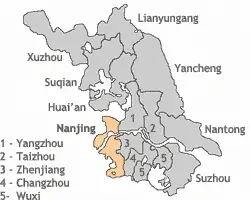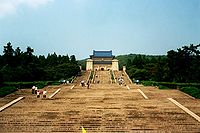Difference between revisions of "Jiangsu" - New World Encyclopedia
Dan Davies (talk | contribs) (New page: {{claimed}} {{coor title dm|33|0|N|120|0|E|region:CN_type:adm1st}} {{Infobox PRC province | Header = '''江苏省 <br/>Jiāngsū Shěng''' | Name = Jiangsu | Abbreviation...) |
Nim Ruparel (talk | contribs) |
||
| Line 209: | Line 209: | ||
==Tourism== | ==Tourism== | ||
[[Nanjing]] was the capital of several Chinese dynasties and contains a variety of historic sites, such as the [[Purple Mountain]], [[Purple Mountain Observatory]], the [[Sun Yat-sen Mausoleum]], [[Ming Dynasty]] city wall and gates, [[Ming Xiaoling Mausoleum]] (The mausoleum of the first Ming Emperor [[Zhu Yuanzhang]]), [[Lake Xuanwu]], [[Jiming Temple]], the [[Nanjing Massacre]] Memorial, Nanjing [[Confucius]] [[Temple]], [[Nanjing Yangtze River Bridge]], and the [[Nanjing Zoo]], with circus. [[Suzhou]] is renowned for its classical gardens (designated as a [[UNESCO]] [[World Heritage Site]]), as well as [[Hanshan Temple]], and [[Huqiu Tower]]. Nearby is the water-town of [[Zhouzhuang]], an international tourist destination where Venice alike waterways, bridges and dwellings have been preserved over centuries. [[Yangzhou]] is known for [[Thin West Lake]]. [[Wuxi]] is known for being the home of the world's tallest buddha statue. In the north, [[Xuzhou]] is designated as one of China's "eminent historical cities". | [[Nanjing]] was the capital of several Chinese dynasties and contains a variety of historic sites, such as the [[Purple Mountain]], [[Purple Mountain Observatory]], the [[Sun Yat-sen Mausoleum]], [[Ming Dynasty]] city wall and gates, [[Ming Xiaoling Mausoleum]] (The mausoleum of the first Ming Emperor [[Zhu Yuanzhang]]), [[Lake Xuanwu]], [[Jiming Temple]], the [[Nanjing Massacre]] Memorial, Nanjing [[Confucius]] [[Temple]], [[Nanjing Yangtze River Bridge]], and the [[Nanjing Zoo]], with circus. [[Suzhou]] is renowned for its classical gardens (designated as a [[UNESCO]] [[World Heritage Site]]), as well as [[Hanshan Temple]], and [[Huqiu Tower]]. Nearby is the water-town of [[Zhouzhuang]], an international tourist destination where Venice alike waterways, bridges and dwellings have been preserved over centuries. [[Yangzhou]] is known for [[Thin West Lake]]. [[Wuxi]] is known for being the home of the world's tallest buddha statue. In the north, [[Xuzhou]] is designated as one of China's "eminent historical cities". | ||
| + | |||
| + | [[image:Sun yatse mausoleum.jpg|thumb|right|200px|Sun-Yat Sen Mausoleum, Nanjing]] | ||
| + | |||
*[[Lion Garden]] in [[Suzhou]] | *[[Lion Garden]] in [[Suzhou]] | ||
Revision as of 17:32, 31 October 2007
| 江苏省 Jiāngsū Shěng | |
| Abbreviations: 苏 (Pinyin: Sū) | |
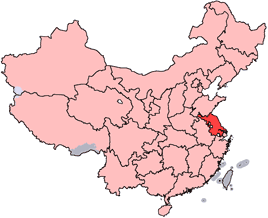
| |
| Origin of name | 江 jiāng - Jiangning (now Nanjing) 苏 sū - Suzhou |
| Administration type | Province 省 |
| Capital (and largest city) |
Nanjing 南京 |
| CPC Ctte Secretary | Liang Baohua 梁保华 |
| Governor | Liang Baohua 梁保华 |
| Area | 102,600 km² (24th) |
| Population (2006) - Density |
75,495,000 (5th) 736/km² (4th) |
| GDP (2006) - per capita |
CNY 2.15 trillion (3rd) CNY 28,685 (5th) |
| HDI (2005) | 0.805 (high) (7th) |
| Major nationalities | Han - 99.6% Hui - 0.2% |
| Prefecture-level | 13 divisions |
| County-level | 106 divisions |
| Township-level† | 1488 divisions |
| ISO 3166-2 | CN-32 |
| Official website http://www.jiangsu.gov.cn/ (Simplified Chinese) | |
| Source for population and GDP data: 《中国统计年鉴—2005》 China Statistical Yearbook 2005 Source for nationalities data:ISBN 7503747382 《2000年人口普查中国民族人口资料》 Tabulation on nationalities of 2000 population census of China † As at December 31, 2004
ISBN 7105054255 | |
Jiangsu ▶ (Simplified Chinese: 江苏; Traditional Chinese: 江蘇; pinyin: Jiāngsū; Wade-Giles: Chiang-su; Postal map spelling: Kiangsu) is a province of the People's Republic of China, located along the east coast of the country. The name comes from jiang, short for the city of Jiangning (now Nanjing), and su, for the city of Suzhou. The abbreviation for this province is "苏" (sū), the second character of its name.
Jiangsu borders Shandong in the north, Anhui to the west, and Zhejiang and Shanghai to the south. Jiangsu has a coastline of over one thousand kilometers along the Yellow Sea, and the Yangtze River passes through its southern parts. Since the inception of economic reforms in 1978, Jiangsu has been a hot spot for economic development, and is now one of China's most prosperous provinces. The wealth divide between the rich southern regions and the north, however, remains a prominent issue in the province.
History
During the earliest Chinese dynasties, the area in what is now Jiangsu was far removed from the center of Chinese civilization, which was in the northwest Henan; it was home of the Huai Yi (淮夷), an ancient ethnic group. During the Zhou Dynasty more contact was made, and eventually the state of Wu (centered at Gusu, now Suzhou) appeared as a vassal to the Zhou Dynasty in south Jiangsu, one of the many hundreds of states that existed across northern and central China at that time. Near the end of the Spring and Autumn Period, Wu became a great power under King Helu of Wu, and was able to defeat in 484 B.C.E. the state of Qi, a major power in the north in modern-day Shandong province, and contest for the position of overlord over all states of China. The state of Wu was subjugated in 473 B.C.E. by the state of Yue, another state that had emerged to the south in modern-day Zhejiang province. Yue was in turn subjugated by the powerful state of Chu from the west in 333 B.C.E. Eventually the state of Qin swept away all the other states, and established China as a unified nation in 221 B.C.E.
Under the reign of the Han Dynasty (206 B.C.E. to 220 C.E.), which brought China to its first golden age, Jiangsu was a relative backwater, far removed from the centers of civilization in the North China Plain. Jiangsu was at that time administered under two zhou (provinces): Xuzhou Province in the north, and Yangzhou Province in the south. Although south Jiangsu was eventually the base for the kingdom of Wu (one of the Three Kingdoms from 222 to 280), it did not become significant role until the invasion of northern nomads during the Western Jin Dynasty, starting from the fourth century. As northern nomadic groups established kingdoms across the north, ethnic Han Chinese aristocracy fled southwards and set up a refugee Eastern Jin Dynasty in 317, in Jiankang (modern day Nanjing). From then until 581 (a period known as the Southern and Northern Dynasties), Nanjing in south Jiangsu was the base of four more ethnic Han Chinese dynasties facing off with northern barbarian (but increasingly sinicized) dynasties. In the meantime, north Jiangsu was a buffer of sorts between north and south; it initially started as a part of southern dynasties, but as northern dynasties gained more ground, it became part of northern dynasties.
In 581 unity was reestablished again, and under the Tang Dynasty (618 to 907) China once more went through a golden age, though Jiangsu at this point was still rather unremarkable among the different parts of China. It was during the Song Dynasty (960-1279), which saw the development of a wealthy mercantile class and emergent market economy in China, that south Jiangsu emerged as a center of trade. From then onwards, south Jiangsu, especially major cities like Suzhou or Yangzhou, would be synonymous with opulence and luxury in China. Today south Jiangsu remains one of the richest parts of China, and Shanghai, arguably the wealthiest and most cosmopolitan of mainland China cities, is a direct extension of south Jiangsu culture.
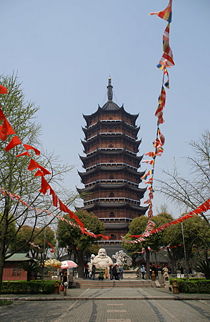
The Jurchen Jin Dynasty gained control of North China in 1127, and the river Huai He, which used to cut through north Jiangsu to reach the Yellow Sea, was the border between the north, under the Jin, and the south, under the Southern Song Dynasty. The Mongols took control of China in the thirteenth century. The Ming Dynasty, which was established in 1368 after driving out the Mongols who had occupied China, initially put its capital in Nanjing. Following a coup by Zhu Di (later Yongle Emperor), however, the capital was moved to Beijing, far to the north. (The naming of the two cities continue to reflect this: "Nanjing" literally means "southern capital", "Beijing" literally means "northern capital.) The entirety of modern day Jiangsu as well as neighbouring Anhui province kept their special status, however, as territory-governed directly by the central government, and were called Nanzhili (南直隸 "Southern directly-governed"). Meanwhile, South Jiangsu continued to be an important center of trade in China; some historians see in the flourishing textiles industry at the time incipient industrialization and capitalism, a trend that was however aborted, several centuries before similar trends took hold in the West.
The Qing Dynasty changed this situation by establishing Nanzhili as Jiangnan province; in 1666 Jiangsu and Anhui were split apart as separate provinces, and Jiangsu was given borders approximately the same as today. With the start of the Western incursion into China in the 1840s, the rich and mercantile south Jiangsu was increasingly exposed to Western influence; Shanghai, originally an unremarkable little town of Jiangsu, quickly developed into a metropolis of trade, banking, and cosmopolitanism, and was split out later as an independent municipality. South Jiangsu also figures strongly in the Taiping Rebellion (1851 – 1864), a massive and deadly rebellion that attempted to set up a Christian theocracy in China; it started far to the south in Guangdong province, swept through much of South China, and by 1853 had established Nanjing as its capital, renamed as Tianjing (天京 "Heavenly Capital").
The Republic of China was established in 1912, and China was soon torn apart by warlords. Jiangsu changed hands several times, but in April 1927 Chiang Kai-Shek established a government at Nanjing; he was soon able to bring most of China under his control. This was however interrupted by the second Sino-Japanese War, which began full-scale in 1937; on December 13, 1937, Nanjing fell, and the combined atrocities of the occupying Japanese for the next 3 months would come to be known as the Nanjing Massacre. Nanjing was the seat of the collaborationist government of East China under Wang Jingwei, and Jiangsu remained under occupation until the end of the war in 1945.
After the war, Nanjing was once again the capital of the Republic of China, though now the Chinese Civil War had broken out between the Kuomintang government and Communist forces, based further north, mostly in Manchuria. The decisive Huaihai Campaign was fought in northern Jiangsu; it resulted in Kuomintang defeat, and the communists were soon able to cross the Yangtze River and take Nanjing. The Kuomintang fled southwards, and eventually ended up in Taipei, from which the Republic of China government continues to administer Taiwan and its neighbouring islands, though it also continues to claim (technically, at least) Nanjing as its rightful capital.
After communist takeover, Beijing was made capital of China and Nanjing was demoted to be the provincial capital of Jiangsu. The economic reforms of Deng Xiaoping initially focused on the south coast of China, in Guangdong province, which soon left Jiangsu behind; starting from the 1990s they were applied more evenly to the rest of China. Suzhou and Wuxi, two southern cities of Jiangsu in close proximity to neighbouring Shanghai Municipality, have since become particularly prosperous, being among the top 10 cities in China in gross domestic product and outstripping the provincial capital of Nanjing. The income disparity between north Jiangsu and south Jiangsu however remains large.
Geography
Jiangsu is very flat and low-lying, with plains covering 68 percent of its total area (water covers another 18 percent), and most of the province not more than fifty meters above sea level. Jiangsu is also laced with a well-developed irrigation system, which earned it (especially the southern half) the moniker of 水乡 (shuǐxiāng "land of water"); the southern city of Suzhou is so crisscrossed with canals that it has been dubbed "Venice of the East". The Grand Canal of China cuts through Jiangsu from north to south, traversing all the east-west river systems. Jiangsu also borders the Yellow Sea. The Yangtze River, the longest river of China, cuts through the province in the south and reaches the East China Sea. Mount Yuntai near the city of Lianyungang is the highest point in this province, with an altitude of 625 meters. Large lakes in Jiangsu include Lake Taihu (the largest), Lake Hongze, Lake Gaoyou, Lake Luoma, and Lake Yangcheng.
Historically, the river Huai He, a major river in central China and the traditional border between North China and South China, cut through north Jiangsu to reach the Yellow Sea. However, starting from 1194 C.E., the Yellow River further to the north changed its course several times, running into the Huai He in north Jiangsu each time instead of its other usual path northwards into Bohai Bay. The silting caused by the Yellow River was so heavy that after its last episode of "hijacking" the Huai He ended in 1855, the Huai He was no longer able to go through its usual path into the sea. Instead it flooded, pooled up (thereby forming and enlarging Lake Hongze and Lake Gaoyou), and flowed southwards through the Grand Canal into the Yangtze. The old path of the Huai He is now marked by a series of irrigation channels, the most significant of which is the North Jiangsu Irrigation Main Channel (苏北灌溉总渠), which channels a small amount of the water of the Huai He along its old path into the sea.
Jiangsu Province spans the warm-temperate/humid and subtropical/humid climate zones, and has clear-cut seasonal changes, with temperatures at an average of -2 to 4°C in January and 26 to 30°C in July. There are frequent rains between spring and summer (meiyu), typhoons with rainstorms in late summer and early autumn. The annual average rainfall is 800 to 1200 mm, concentrated mostly in summer when the southeast monsoon carries rainwater into the province.
Major cities:
|
|
|
|
Administrative divisions
Jiangsu is divided into thirteen prefecture-level divisions, all prefecture-level cities:
- Nanjing (Simplified Chinese: 南京市, Hanyu Pinyin: Nánjīng Shì)
- Xuzhou (徐州市 Xúzhōu Shì)
- Lianyungang (连云港市 Liányúngǎng Shì)
- Suqian (宿迁市 Sùqiān Shì)
- Huai'an (淮安市 Huái'ān Shì)
- Yancheng (盐城市 Yánchéng Shì)
- Yangzhou (扬州市 Yángzhōu Shì)
- Taizhou (泰州市 Tàizhōu Shì)
- Nantong (南通市 Nántōng Shì)
- Zhenjiang (镇江市 Zhènjiāng Shì)
- Changzhou (常州市 Chángzhōu Shì)
- Wuxi (无锡市 Wúxī Shì)
- Suzhou (苏州市 Sūzhōu Shì)
The thirteen prefecture-level divisions of Jiangsu are subdivided into 106 county-level divisions (54 districts, 27 county-level cities, and 25 counties). Those are in turn divided into 1488 township-level divisions (1078 towns, 122 townships, one ethnic township, and 287 subdistricts).
See List of administrative divisions of Jiangsu for a complete list of county-level divisions.
Economy
Jiangsu has an extensive irrigation system supporting its agriculture, which is based primarily on rice and wheat, followed by maize and sorghum. Main cash crops include cotton, soybeans, peanuts, rape, sesame, ambary hemp, and tea. Other products include peppermint, spearmint, bamboo, medicinal herbs, apples, pears, peaches, loquats, ginkgo. Silkworms also form an important part of Jiangsu's agriculture, with the Lake Taihu region to the south a major base of silk production in China. Jiangsu is also an important producer of freshwater fish and other aquatic products.
Jiangsu has coal, petroleum, and natural gas deposits, but its most significant mineral products are non-metal minerals such as halite (rock salt), sulfur, phosphorus, and marble. The salt mines of Huaiyin have more than 0.4 trillion tonnes of deposits, one of the greatest collections of deposits in China.
Jiangsu is historically oriented towards light industries such as textiles and food industry. Since 1949, Jiangsu has also developed heavy industries such as chemical industry and construction materials. Jiangsu's important industries include machinery, electronic, chemicals, and automobile [1]. The economic reforms of Deng Xiaoping has greatly benefited southern cities, especially Suzhou and Wuxi, which outstrip the provincial capital Nanjing in total output. In the eastern outskirts of Suzhou, Singapore has built the Suzhou Industrial Park, a flagship of PRC-Singapore cooperation and the only industrial park in China that is in its entirety the investment of one single foreign country.
Jiangsu is very wealthy among the provinces of China, with the second highest total GDP (after Guangdong Province). Its GDP per capita was 14,500 yuan in 2002, but geographical disparity is great, and southern cities like Suzhou and Wuxi have GDP per capita around twice the provincial average, making south Jiangsu one of the most prosperous regions in China.
In 2004, Jiangsu's nominal GDP was 1.54 trillion yuan (US$191.42 billion), making it the third largest GDP of all the provinces and an annual growth rate of 13.5%. Its per capita GDP was 16,796 yuan (US$2,029). The share of GDP of Jiangsu's primary, secondary, and tertiary industries were 8.9%, 54.5%, and 36.6% respectively. The share of GDP by the public and private sector was 49.0% and 51.0% respectively.
Demographics
The majority of Jiangsu residents are ethnic Han Chinese. Other minorities include the Hui and the Manchus.
- Demographic indicators in 2000
Population: 74.058 million (urban: 34.637 million; rural: 39.421 million) (2003)
Birth rate: 9.04 per 1000 (2003)
Death rate: 7.03 per 1000 (2003)
Sex ratio: 102.55 males per 100 females
Average family size: 3.25
Han Chinese proportion: 99.64%
Illiteracy rate: 7.88%
Culture
The province of Jiangsu was formed in the seventeenth century. Before then, the northern and southern parts of Jiangsu had less connection than that later. Traditionally, South Jiangsu is referred to as the three more prosperous southern cities including Suzhou, Wuxi and Changzhou. Their culture is more southern than the rest and is oftened referred to as the Wu. All the other parts of the province is dominated by the so-called "Jianghuai Culture", which means the culture in the area between the Yangtse River (Jiang) and Huaihe River (Huai), though not all of them lie within the district defined by the term. In history, the term North Jiangsu refers to the cities to the north of the Yangtze River. For cities of Nanjing and Zhenjiang, neither the two terms (North Jiangsu and South Jiangsu) refers to them, because though they are to the south of the River, culturally they are still of the Jianghuai Region. Since about 1998, there is a new classification used frequently by the government and defined by economic means. It groups all the cities to the south of the Yangtse River as South Jiangsu, the cities of Yangzhou, Nantong and Taizhou as Middle Jiangsu, and all the rest as North Jiangsu.
Though the terms of classification are very complex, by cultural means only the very north cities of Xuzhou and Lianyugang are culturally north Chinese. All the rest areas of the province are culturally south, though the three South Jiangsu cities are more purely southern while the culture in other cities is more a transitional mixture dominated by the southern.
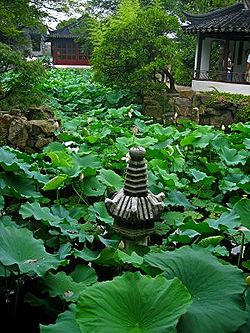
Two main subdivisions of the Chinese language, Mandarin (not Putonghua, the national standard speech based on the Beijing dialect, also commonly called Mandarin) and Wu, are spoken in different parts of Jiangsu. Dialects of Mandarin are spoken over the traditional North Jiangsu, Nanjing and Zhenjiang, while Dialect of Wu is used in South Jiangsu. Mandarin and Wu are not mutually intelligible and the dividing line is sharp and well-defined. (See also Nanjing dialect, Xuzhou dialect, Yangzhou dialect, Suzhou dialect, Wuxi dialect, Changzhou dialect). In addition, Standard Chinese (Putonghua/Mandarin) is also spoken by most people.
Jiangsu is rich in cultural traditions. Kunqu, originating in Kunshan, is one of the most renowned and prestigious forms of Chinese opera. Pingtan, a form of storytelling accompanied by music, is also popular: it can be subdivided into types by origin: Suzhou Pingtan (of Suzhou), Yangzhou Pingtan (of Yangzhou), and Nanjing Pingtan (of Nanjing). Xiju, a form of traditional Chinese opera, is popular in Wuxi, while Huaiju is popular further north, around Yancheng. Jiangsu cuisine is one of the eight great traditions of the cuisine of China.
Suzhou is also famous for its silk, embroidery art, jasmine tea, stone bridges, pagodas, and its classical gardens. Nearby Yixing is famous for its teaware, and Yangzhou is famous for its lacquerware and jadeware. Nanjing's yunjin is a famous form of woven silk, while Wuxi is famous for its peaches.
Since ancient times, south Jiangsu has been famed for its prosperity and opulence, and simply inserting south Jiangsu place names (Suzhou, Yangzhou, etc.) into poetry gave an effect of dreaminess, as was indeed done by many famous poets. In particular, the fame of Suzhou (as well as Hangzhou in neighbouring Zhejiang province) has led to the popular saying: 上有天堂,下有蘇杭 (above there is heaven; below there is Suzhou and Hangzhou), a saying that continues to be a source of pride for the people of these two still prosperous cities. Similarly, the prosperity of Yangzhou has led poets to dream of: 腰纏十萬貫,騎鶴下揚州 (with a hundred thousand strings of coins wrapped around the waist, riding a crane down to Yangzhou).
Notables
This is a list of famous people from Jiangsu in chronological order. Note that modern-day Jiangsu Province dates from the seventeenth century, so most of the people in this list would not recognise it.
- King Helu of Wu (died 496 B.C.E.), king of the state of Wu.
- Gan Jiang
- Mo Xie
- Xiang Yu (232 – 202 B.C.E.), warlord at the end of Qin Dynasty.
- Emperor Gao of Han (256 – 195 B.C.E.), first emperor of Han Dynasty.
- The Han Dynasty generals Han Xin, Xiao He and Cao Shen.
- Zhang Zhao, Three Kingdoms era strategist.
- Lu Xun, Three Kingdoms era strategist and general.
- Ge Hong
- Tao Hongjing
- Gu Kaizhi (348 – 409), painter.
- Lu Ji
- Lu Yun
- Emperor Wu of Song (363 – 422), first emperor of the Song Dynasty (420-479).
- Zhang Xu, Tang Dynasty calligrapher.
- Li Houzhu (937 – 978), last emperor of Later Tang Dynasty, poet.
- Fan Zhongyan (989 – 1052), Song Dynasty politician, poet.
- Shen Kuo (1031 – 1095), Song Dynasty scientist, general, and statesman
- Fan Chengda
- Gu Xiancheng
- Xu Xiake (1586 – 1641), travel writer.
- Shen Zhou
- Wen Zhengming
- Tang Bohu (1470 - 1524), artist
- Dong Qichang
- Zhu Yunming
- Wu Cheng'en (died 1582), author of Journey to the West.
- Gui Youguang
- Feng Menglong
- Zheng Banqiao (1693 – 1765), poet, painter, scholar.
- Jin Shengtan (1608 – 1661), writer, critic.
- Gu Yanwu
- Zhao Yi
- Liu E
- Hsing Yun (born 1927), Buddhist monk.
- Xu Beihong (1895 – 1953), painter.
- Mei Lanfang (1894 – 1961), Beijing opera actor.
- Liu Tianhua (1895 – 1932), musician and composer.
- Zhou Enlai (1898 – 1976), former Premier of the People's Republic of China.
- Zhou Xuan Chinese singer and actress
- Jiang Zemin (born 1926), former President of the People's Republic of China
- Hu Jintao (born 1942), current President of the People's Republic of China
- Hau Pei-tsun, Retired general of the ROC Army, former Premier of the Republic of China
Tourism
Nanjing was the capital of several Chinese dynasties and contains a variety of historic sites, such as the Purple Mountain, Purple Mountain Observatory, the Sun Yat-sen Mausoleum, Ming Dynasty city wall and gates, Ming Xiaoling Mausoleum (The mausoleum of the first Ming Emperor Zhu Yuanzhang), Lake Xuanwu, Jiming Temple, the Nanjing Massacre Memorial, Nanjing Confucius Temple, Nanjing Yangtze River Bridge, and the Nanjing Zoo, with circus. Suzhou is renowned for its classical gardens (designated as a UNESCO World Heritage Site), as well as Hanshan Temple, and Huqiu Tower. Nearby is the water-town of Zhouzhuang, an international tourist destination where Venice alike waterways, bridges and dwellings have been preserved over centuries. Yangzhou is known for Thin West Lake. Wuxi is known for being the home of the world's tallest buddha statue. In the north, Xuzhou is designated as one of China's "eminent historical cities".
- Lion Garden in Suzhou
- Grand Buddha at Ling Shan, Wuxi
- Chaotian Palace
- Gulin Park
- Jiangxin Island
- Night Markets
- Qixia Temple in Qixia Mountains
- Swallow Rock in Yanziji
- Tombs of Southern Tang Emperor
Miscellaneous topics
Sports
Professional sports teams in Jiangsu include:
- Chinese Football Association Jia League
- Jiangsu Shuntian
- Nanjing Youyou
- Chinese Basketball Association
- Jiangsu Nan'gang Dragons
Colleges and universities
Nanjing
- Nanjing Aeronautics and Astronautics University
- Nanjing University of Finance & Economics
- Nanjing Agricultural University
- Nanjing Medical University
- Nanjing Normal University
- Nanjing University
- Nanjing University of Science and Technology
- Southeast University
Suzhou
- Suzhou Medical College
- Suzhou University
External links
- The Provincial Government of Jiangsu
- Large map of Jiangsu
- Jiangsu NET - Travel, Recreation, Business, and Other Services
Aural
- National Public Radio story about Huaxi, Jiangsu, May 16, 2006.
| Province-level divisions administered by the People's Republic of China (PRC) | |
|---|---|
| Provinces | Anhui · Fujian · Gansu · Guangdong · Guizhou · Hainan · Hebei · Heilongjiang · Henan · Hubei · Hunan · Jiangsu · Jiangxi · Jilin · Liaoning · Qinghai · Shaanxi · Shandong · Shanxi · Sichuan · Taiwan · Yunnan · Zhejiang |
| Autonomous regions | Guangxi · Inner Mongolia · Ningxia · Tibet (Xizang) · Xinjiang |
| Municipalities | Beijing · Chongqing · Shanghai · Tianjin |
| Special administrative regions | Hong Kong · Macau |
Prefecture-level divisions of Jiangsu
| ||||
| List of Jiangsu County-level divisions |
Credits
New World Encyclopedia writers and editors rewrote and completed the Wikipedia article in accordance with New World Encyclopedia standards. This article abides by terms of the Creative Commons CC-by-sa 3.0 License (CC-by-sa), which may be used and disseminated with proper attribution. Credit is due under the terms of this license that can reference both the New World Encyclopedia contributors and the selfless volunteer contributors of the Wikimedia Foundation. To cite this article click here for a list of acceptable citing formats.The history of earlier contributions by wikipedians is accessible to researchers here:
The history of this article since it was imported to New World Encyclopedia:
Note: Some restrictions may apply to use of individual images which are separately licensed.
